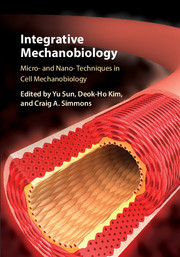Book contents
- Integrative Mechanobiology
- Integrative Mechanobiology
- Copyright page
- Contents
- Contributors
- Preface
- Part I Micro-nano techniques in cell mechanobiology
- 1 Nanotechnologies and FRET imaging in live cells
- 2 Electron microscopy and three-dimensional single-particle analysis as tools for understanding the structural basis of mechanobiology
- 3 Stretchable micropost array cytometry
- 4 Microscale generation of dynamic forces in cell culture systems
- 5 Multiscale topographical approaches for cell mechanobiology studies
- 6 Hydrogels with dynamically tunable properties
- 7 Microengineered tools for studying cell migration in electric fields
- 8 Laser ablation to investigate cell and tissue mechanics in vivo
- 9 Computational image analysis techniques for cell mechanobiology
- 10 Micro- and nanotools to probe cancer cell mechanics and mechanobiology
- 11 Stimuli-responsive polymeric substrates for cell-matrix mechanobiology
- Part II Recent progress in cell mechanobiology
- Index
- References
3 - Stretchable micropost array cytometry
A powerful tool for cell mechanics and mechanobiology research
from Part I - Micro-nano techniques in cell mechanobiology
Published online by Cambridge University Press: 05 November 2015
- Integrative Mechanobiology
- Integrative Mechanobiology
- Copyright page
- Contents
- Contributors
- Preface
- Part I Micro-nano techniques in cell mechanobiology
- 1 Nanotechnologies and FRET imaging in live cells
- 2 Electron microscopy and three-dimensional single-particle analysis as tools for understanding the structural basis of mechanobiology
- 3 Stretchable micropost array cytometry
- 4 Microscale generation of dynamic forces in cell culture systems
- 5 Multiscale topographical approaches for cell mechanobiology studies
- 6 Hydrogels with dynamically tunable properties
- 7 Microengineered tools for studying cell migration in electric fields
- 8 Laser ablation to investigate cell and tissue mechanics in vivo
- 9 Computational image analysis techniques for cell mechanobiology
- 10 Micro- and nanotools to probe cancer cell mechanics and mechanobiology
- 11 Stimuli-responsive polymeric substrates for cell-matrix mechanobiology
- Part II Recent progress in cell mechanobiology
- Index
- References
Summary
It has become increasingly appreciated that living mammalian cells are not just complex biochemical reactors but also sophisticated biomechanical systems that can adapt their mechanical properties to various signals and perturbations from the extracellular space, and integrate with intracellular signaling events through a process called mechanotransduction, to regulate cell behaviors. To gain fundamental insights into such biomechanical nature of mammalian cells, many biomechanical tools have been developed with unprecedented spatiotemporal resolutions covering both molecular and cellular length scales. In this chapter, we describe a recently developed biomechanical tool, termed “stretchable micropost array cytometry” (SMAC), which is capable of quantitative control and real-time measurements of both mechanical stimuli and cellular biomechanical responses with a high spatiotemporal subcellular resolution. We further discuss implementations of the SMAC for characterizing cell cytoskeletal contractile force, cell stiffness, and cell adhesion signaling and dynamics at both whole-cell and subcellular scales in real time. We conclude with remarks regarding future improvements and applications of the SMAC for cell mechanics and mechanobiology studies.
- Type
- Chapter
- Information
- Integrative MechanobiologyMicro- and Nano- Techniques in Cell Mechanobiology, pp. 32 - 46Publisher: Cambridge University PressPrint publication year: 2015



